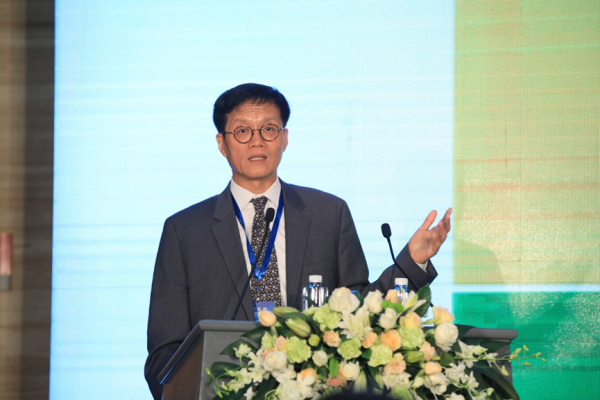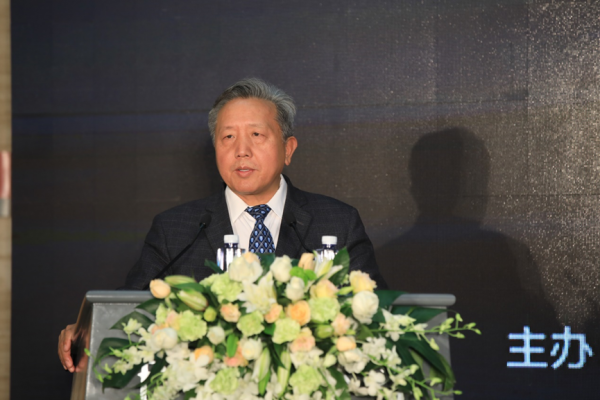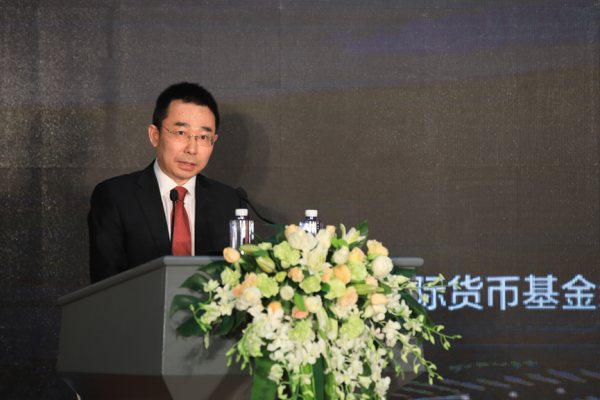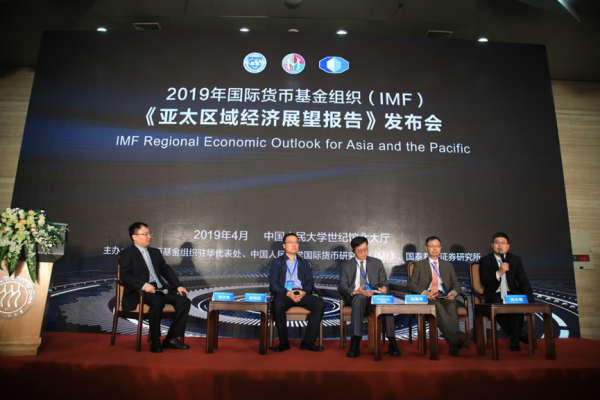Launch of 2019 IMF Regional Economic Outlook for Asia and the Pacific
2019-04-23 IMI In the opening remarks, Prof. Zhang Jie said that IMI and IMF have been teaming up for a long term, jointly releasing the IMF World Economic Outlook and the IMF Regional Economic Outlook for Asia and the Pacific every year, working together on the study and exploration of international macroeconomics and monetary and financial strategies, enabling international talents to be skilled in both finance and diplomacy and to accomplish the missions of the times and contributing to the development of global finance together.
In the opening remarks, Prof. Zhang Jie said that IMI and IMF have been teaming up for a long term, jointly releasing the IMF World Economic Outlook and the IMF Regional Economic Outlook for Asia and the Pacific every year, working together on the study and exploration of international macroeconomics and monetary and financial strategies, enabling international talents to be skilled in both finance and diplomacy and to accomplish the missions of the times and contributing to the development of global finance together.
 Mr. Changyong Rhee first pointed out that Asian economy will follow a cold winter in the near future. The main reasons are as follows: First, the trade frictions between countries are escalating. Second, the major emerging economies in Asia are facing inflationary pressures and the risk of depreciation of their currencies. Third, rising oil prices has imposed more pressure on emerging Asian economies. On this basis, some uncertain factors will also have potential impacts on Asian economic development, including the Brexit uncertainty and the geopolitical issues of Argentina, which requires policy-makers getting prepared in time. At the same time, the easing of Sino-US trade frictions and the normalization of US monetary policy have facilitated the economic development of the Asia-Pacific region. Later, Changyong Rhee looked ahead to the trends in major Asian economies. He believed that the Asian economy has maintained the growth momentum and will contribute 60% of the global GDP growth in this year and next. Regarding the prospects of China's economy, he believed that with the mixed effects of state incentives and external demand changes, China’s economic growth is projected to slip by 0.1% and still faces downward pressure. However, due to the massive scale of Chinese market, China's economic growth will still account for a large proportion of global economic growth.
Mr. Changyong Rhee first pointed out that Asian economy will follow a cold winter in the near future. The main reasons are as follows: First, the trade frictions between countries are escalating. Second, the major emerging economies in Asia are facing inflationary pressures and the risk of depreciation of their currencies. Third, rising oil prices has imposed more pressure on emerging Asian economies. On this basis, some uncertain factors will also have potential impacts on Asian economic development, including the Brexit uncertainty and the geopolitical issues of Argentina, which requires policy-makers getting prepared in time. At the same time, the easing of Sino-US trade frictions and the normalization of US monetary policy have facilitated the economic development of the Asia-Pacific region. Later, Changyong Rhee looked ahead to the trends in major Asian economies. He believed that the Asian economy has maintained the growth momentum and will contribute 60% of the global GDP growth in this year and next. Regarding the prospects of China's economy, he believed that with the mixed effects of state incentives and external demand changes, China’s economic growth is projected to slip by 0.1% and still faces downward pressure. However, due to the massive scale of Chinese market, China's economic growth will still account for a large proportion of global economic growth.
 Prof. Wu Xiaoqiu categorized important factors for sustained and steady growth of China’s economy into seven parts: First, lower the target growth rate to 6%-6.5%. Second, promote structural transformation. It’s the key to reduce the excessive dependence on natural resources and inefficient capacity and develop high-tech industrial clusters and competitive industrial structure. Third, continue to deepen reforms that guided by market orientation. Let the market play the decisive role in allocating resources and strike a balance between the role of the government and that of the market. Fourth, keep policies coordinated and adaptable. Especially adjust fiscal and tax policies in accordance with the business cycle. Fifth, boost innovation especially scientific and technological innovation. Chinese enterprises are supposed to take the lead in new materials, new energy, artificial intelligence, life science and other fields in the future. Sixth, expand opening up. Sino-US relationship is the most important part of China's foreign relations. China and the United States must solve various problems based on mutual benefit, respect and consultation. Seventh, improve labor force quality. Middle income trap is mainly caused by the contradiction between low labor force quality and the needs for high growth. Therefore, it’s necessary to cultivate innovative talents for economic development. Finally, he expressed his optimism for China’s economy.
Prof. Wu Xiaoqiu categorized important factors for sustained and steady growth of China’s economy into seven parts: First, lower the target growth rate to 6%-6.5%. Second, promote structural transformation. It’s the key to reduce the excessive dependence on natural resources and inefficient capacity and develop high-tech industrial clusters and competitive industrial structure. Third, continue to deepen reforms that guided by market orientation. Let the market play the decisive role in allocating resources and strike a balance between the role of the government and that of the market. Fourth, keep policies coordinated and adaptable. Especially adjust fiscal and tax policies in accordance with the business cycle. Fifth, boost innovation especially scientific and technological innovation. Chinese enterprises are supposed to take the lead in new materials, new energy, artificial intelligence, life science and other fields in the future. Sixth, expand opening up. Sino-US relationship is the most important part of China's foreign relations. China and the United States must solve various problems based on mutual benefit, respect and consultation. Seventh, improve labor force quality. Middle income trap is mainly caused by the contradiction between low labor force quality and the needs for high growth. Therefore, it’s necessary to cultivate innovative talents for economic development. Finally, he expressed his optimism for China’s economy.
 Mr. Wang Song pointed out that China’s economy is in the stage of strategic transformation from the middle-high income country to the high income country, requiring the increase of total factor productivity. At present, the fourth industrial revolution is a once-in-a-lifetime opportunity for China. Whether China can exploit the demographic dividend to support the rise of China's high-end manufacture and the transformation of its economic structure, as well as seize the advantages of the total scale in the current information-based and intelligent technology revolution are the decisive factors for China to promote industrial development and change the structure of industrial.
Mr. Wang Song pointed out that China’s economy is in the stage of strategic transformation from the middle-high income country to the high income country, requiring the increase of total factor productivity. At present, the fourth industrial revolution is a once-in-a-lifetime opportunity for China. Whether China can exploit the demographic dividend to support the rise of China's high-end manufacture and the transformation of its economic structure, as well as seize the advantages of the total scale in the current information-based and intelligent technology revolution are the decisive factors for China to promote industrial development and change the structure of industrial.
 The panel discussion was chaired by Dr. Li Shaojun. Mr. Changyong Rhee, Prof. Zhao Xijun, Dr. Zhao Bogong, and Dr. Hua Changchun discussed the global economic growth momentum, the role of asset management industry in credit expansion, the demand and relative monetary policies of China's finance for achieving high-quality two-way opening up and other issues.
The panel discussion was chaired by Dr. Li Shaojun. Mr. Changyong Rhee, Prof. Zhao Xijun, Dr. Zhao Bogong, and Dr. Hua Changchun discussed the global economic growth momentum, the role of asset management industry in credit expansion, the demand and relative monetary policies of China's finance for achieving high-quality two-way opening up and other issues.
